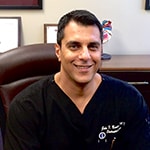What is Pacemaker Implantation?
A pacemaker is a small electronic device that is used to regulate electrical impulses in the heart. This can help to control an irregular heartbeat (arrhythmia), especially one that is too slow. Pacemaker implantation involves surgically placing the device in the chest. The device monitors the heart’s electrical activity, regulating the impulses sent to the heat to stimulate regular heartbeats.
Why is a Pacemaker Implantation Done?
A pacemaker consists of three different parts that work together to signal the heart to beat. These include a pulse generator with one or more leads, each with an electrode on the end. The electrodes monitor the heart’s electrical activity, sensing when the heart rate is too slow and sending electrical activity to regulate it.
When is a Pacemaker Needed?
Dr. Beshai may suggest patients get a pacemaker when tests have determined that the heartbeat is irregular or too slow, resulting in the following symptoms:
- Dizziness
- Fatigue
- Fainting
- Chest pain
There are several conditions that can cause an irregular or slow heartbeat. Once properly diagnosed, board-certified cardiologist Dr. Beshai can recommend a pacemaker to monitor and maintain the heart’s healthy rhythm, ensuring that the body receives enough blood.
Have Inquiries About Our Services?
How is Pacemaker Implantation Performed?
To begin your pacemaker insertion, an IV will be started to deliver mediation and fluids as needed during the procedure. You will then be connected to an electrocardiogram (ECG) to monitor your heart’s electrical activity. Sedation will be administered to keep you fully relaxed during the pacemaker insertion, and local anesthesia will be administered to the placement site. A sheath, or plastic tube, is then inserted into a blood vessel just under the collarbone. The pacemaker’s lead wires are then inserted into the tube and directed through the blood vessel to the heart.
Once inside the heart, the lead wires will be tested to ensure they are working and properly in place. The lead wires are then attached to a generator, and the generator is placed under the skin through a small incision. Once Dr. Beshai knows everything is working properly, the incision is closed and bandaged.
What are the Next Steps After Getting a Pacemaker?
After a pacemaker insertion, you will be taken to a recovery room to rest and be monitored. Once the sedation has worn off, you will have assistance with getting up and eating and drinking. You may feel some soreness at the placement site. You will be able to return to your daily routine within a few days, but you should avoid heavy lifting and limit arm movement for several weeks or until Dr. Beshai gives you the OK.
Once you have a pacemaker inserted, it is very important to always carry an ID card stating that you have a pacemaker. It is also a good idea to wear a bracelet indicating you have a pacemaker. Metal detectors are generally safe for pacemakers, but always let the people monitoring them know that you have the device, as a pacemaker may set off the detector. Detector wands should not be held over the pacemaker for longer than a few seconds. Avoid MRI scans and any sites with large magnetic fields.
You will have regular follow-up appointments with Dr. Beshai to ensure that the pacemaker is working properly. Contact your doctor if you feel ill after an activity or an injury involving the chest.
Scheduling Your Pacemaker Appointment
Dr. Beshai offers pacemaker insertion to help regulate an irregular or slow heartbeat to avoid bothersome symptoms or even heart failure. To learn more about the pacemaker and its benefits, contact our office and schedule your appointment at the Heart Rhythm Institute of Arizona.
The Heart Institute of Arizona has a wide array of services that come with our premium care. From in-office diagnostics and treatable conditions to hospital-based procedures, we’ve got your heart covered.
Dr. Beshai is a board-certified electrophysiologist internationally renowned and respected for his expertise and research. Having published in major medical journals and travelled all over the world to present research, he is dedicated to providing innovative, state-of-the-art care to his patients.
- John F. Beshai, MDhttps://heartbeataz.com/author/heartbeata/
- John F. Beshai, MDhttps://heartbeataz.com/author/heartbeata/
- John F. Beshai, MDhttps://heartbeataz.com/author/heartbeata/
- John F. Beshai, MDhttps://heartbeataz.com/author/heartbeata/

